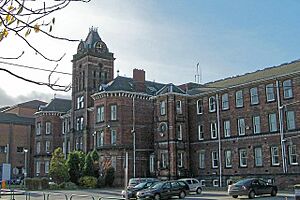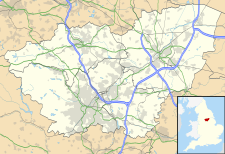Northern General Hospital facts for kids
Quick facts for kids Northern General Hospital |
|
|---|---|
| Sheffield Teaching Hospitals NHS Foundation Trust | |

The hospital in 2008
|
|
| Geography | |
| Location | Herries Road, Fir Vale, Sheffield, South Yorkshire, England |
| Coordinates | 53°24′39″N 1°27′30″W / 53.41083°N 1.45833°W |
| Organisation | |
| Care system | NHS England |
| Hospital type | Teaching |
| Affiliated university | |
| Services | |
| Emergency department | Yes – Major Trauma Centre |
| Helipad | Yes |
| Beds | 1,100 |
| History | |
| Founded | 1878 (as Fir Vale Workhouse) |
The Northern General Hospital is a large teaching hospital in Sheffield, England. As a teaching hospital, it helps train future doctors and nurses. It is also a Major Trauma Centre, which means it is specially equipped to handle the most serious life-threatening injuries.
The hospital's accident and emergency (A&E) department is for adults. Children who need emergency care are usually treated at the Sheffield Children's Hospital. The hospital is run by the Sheffield Teaching Hospitals NHS Foundation Trust.
Contents
History of the Hospital
The hospital's story began in 1878. It started as part of a place called the Fir Vale Workhouse, which had a section for sick people called an infirmary. This infirmary officially opened in 1881.
Changes and Growth
Over the years, the hospital changed its name several times. In 1906, the infirmary was rebuilt and became the Sheffield Union Hospital. Later, it was called the City General Hospital.
A major medical achievement happened here in 1955. Doctors at the City General Hospital performed the world's first heart valve replacement surgery. In 1967, the hospital merged with another facility and was finally named the Northern General Hospital.
In 1989, the hospital played a key role in caring for people injured in the Hillsborough disaster.
Becoming a Modern Hospital
The hospital continued to grow and add new services. When Lodge Moor Hospital closed in 1994, its services for chest and spinal injuries moved to the Northern General.
In 2012, it became a Major Trauma Centre. This means it has expert doctors and special operating rooms ready 24/7 for emergencies. It also has a helipad, so patients can be brought in quickly by helicopter. A new £2 million helipad, funded by charity, opened in 2016 to be closer to the A&E department.
Services and Buildings
The hospital is very large, like a small village with many different buildings. Many of these buildings, called wings, are named after important people from Sheffield's history, especially from its famous steel industry.
What are the main buildings for?
- The Huntsman Building: Named after Benjamin Huntsman, a steel maker. This is a very busy building. It has the A&E department, the Surgical Assessment Centre, X-ray rooms, and operating theatres.
- The Firth Wing: Named for industrialist Mark Firth. This wing focuses on heart care and surgery for blood vessels.
- The Chesterman Wing: Named after James Chesterman, a manufacturer. This is the main centre for heart conditions (cardiology).
- The Vickers Corridor: Named after Edward Vickers, an industrialist. This area treats kidney and hormone-related problems. It also has parts of the Sheffield Medical School.
- The Sorby Wing: Named for scientist Henry Clifton Sorby. This wing has the kidney disease outpatient unit.
- The Osborn Building: Named for steelmaker Sir Samuel Osborn. This is where the hospital's special unit for spinal injuries is located.
- The Brearley Wing: Named after Harry Brearley, who invented stainless steel. This wing has wards for breathing problems and patient recovery (rehabilitation).
- The Hadfield Wing: Named for metallurgist Sir Robert Hadfield. This building has several departments, including a ward for patients with hip fractures.
Other important areas include the critical care department, which has the intensive care unit (ICU) for the most seriously ill patients. The historic Clock Tower Building is now used for offices, including finance and security.
How to Get to the Hospital
The hospital is easy to reach by bus. Both First South Yorkshire and Stagecoach Yorkshire run regular bus services that stop directly at the hospital grounds.


